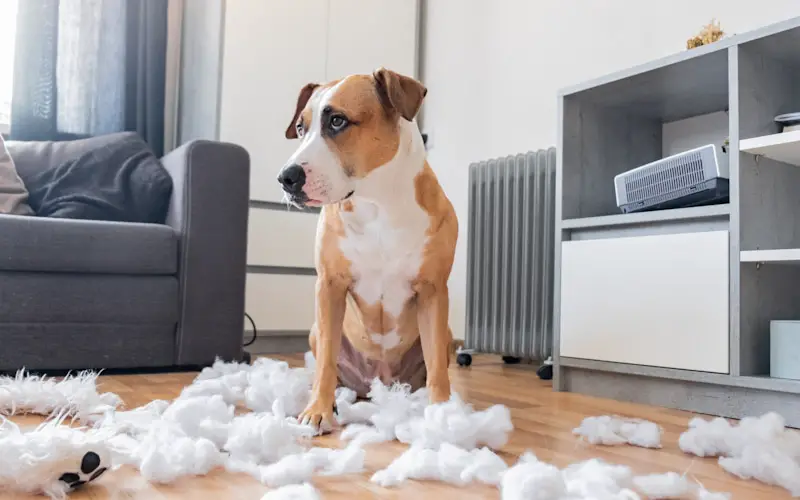Have you ever come home to find your dog looking guilty after doing something bad, like chewing your shoes or making a mess on the floor? You may think that your dog knows that he did something wrong and feels sorry for it. But do dogs really feel guilt, or are they just reacting to your tone of voice and body language?

The Guilty Look
The guilty look is a common expression that dogs show when they are scolded by their owners. It usually involves some or all of the following behaviors:
- Tucked tail
- Visible whites of the eyes
- Cowering, hunched posture
- Yawning
- Licking
- Flattened ears
- Avoiding eye contact
These behaviors may seem to indicate that the dog is feeling guilty, ashamed, or remorseful for his actions. However, according to animal behavior experts, these behaviors are more likely to be signs of fear, stress, or submission.
Appeasement or Fear?
Dogs are social animals that have evolved to live in groups with a hierarchy of dominance and submission. They use body language to communicate their emotions and intentions to other dogs and humans. When a dog feels threatened, scared, or intimidated by a more dominant individual, he may display appeasement or fear behaviors to avoid conflict and show respect.
Appeasement behaviors are actions that a dog performs to signal that he is not a threat and that he wants to maintain a peaceful relationship. For example, a dog may lick his lips, lower his head, or roll over to expose his belly. These behaviors are meant to show that the dog is friendly and submissive.

Fear behaviors are actions that a dog performs to express that he is afraid and wants to escape or avoid a scary situation. For example, a dog may tuck his tail, cower, or hide behind an object. These behaviors are meant to show that the dog is vulnerable and helpless.
Both appeasement and fear behaviors can be triggered by the owner’s negative reactions, such as scolding, yelling, or hitting. The dog may not understand why the owner is angry, but he can sense the owner’s emotions and body language. The dog may then display the guilty look to try to appease the owner or to reduce the intensity of the punishment.
What Does the Research Say?
Several studies have been conducted to investigate whether dogs feel guilt or not. One of the most famous studies was done by Dr. Alexandra Horowitz, a dog cognition scientist and author of the book Inside of a Dog: What Dogs See, Smell, and Know. She tested 14 dogs and their owners in different scenarios where the dogs were either allowed or forbidden to eat a treat while the owners were out of the room. When the owners returned, they were either told the truth or lied about what the dogs did. The owners then scolded or praised the dogs accordingly.
The results showed that the dogs displayed the guilty look more often when the owners scolded them, regardless of whether they ate the treat or not. The dogs also displayed the guilty look more often when they were falsely accused of eating the treat, compared to when they were correctly accused. This suggests that the dogs were not feeling guilty, but rather responding to the owner’s cues and expectations.
Other studies have also supported the idea that dogs do not feel guilt, but rather learn to associate certain situations with the owner’s reactions. For example, a study by Dr. Julie Hecht and colleagues found that dogs who had a history of stealing food showed more guilty behaviors than dogs who did not, even when they did not steal anything. This implies that the dogs had learned to anticipate the owner’s anger and tried to appease them with the guilty look.

How to Deal with Your Dog’s Bad Behavior
If dogs do not feel guilt, then how can we teach them right from wrong? The answer is to use positive reinforcement training, which is a method of teaching that rewards good behavior and ignores or redirects bad behavior. Positive reinforcement training is based on the principle that behaviors that are rewarded are more likely to be repeated, while behaviors that are ignored or punished are less likely to be repeated.
Positive reinforcement training has many benefits for both dogs and owners. It can help to:
- Strengthen the bond between you and your dog
- Increase your dog’s confidence and trust
- Reduce your dog’s stress and anxiety
- Improve your dog’s learning and problem-solving skills
- Prevent or correct unwanted behaviors
To use positive reinforcement training, you will need to:
- Identify what motivates your dog, such as treats, toys, praise, or attention
- Reward your dog immediately and consistently for performing the desired behavior
- Ignore or redirect your dog when he performs the undesired behavior
- Avoid scolding, yelling, or hitting your dog, as this can cause fear, aggression, or confusion
- Be patient, consistent, and clear with your expectations and commands

Conclusion
Dogs often look guilty after doing something bad, but they may not actually feel guilty. They may be displaying appeasement or fear behaviors in response to their owner’s negative reactions. These behaviors are not a sign of remorse or understanding of wrongdoing, but rather a way of avoiding conflict and showing respect.
If you want to teach your dog how to behave properly, you should use positive reinforcement training, which is a humane and effective way of rewarding good behavior and ignoring or redirecting bad behavior. By doing so, you can help your dog learn what you want him to do, while also strengthening your relationship and improving his well-being.